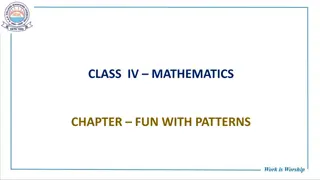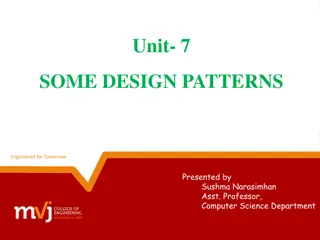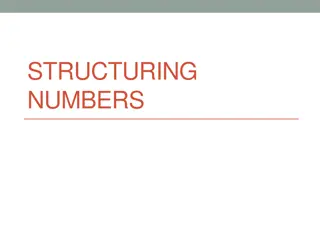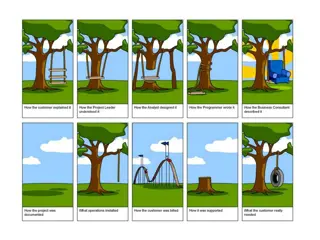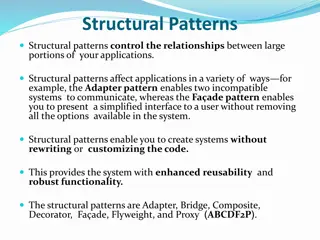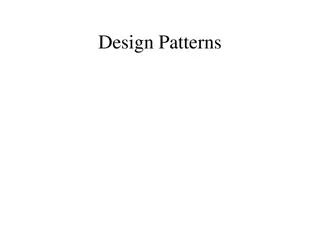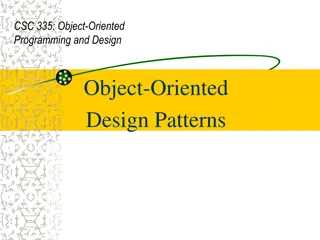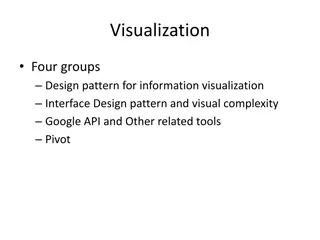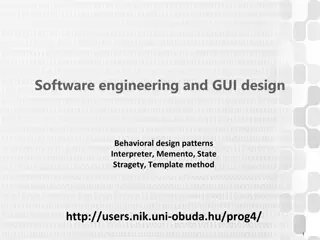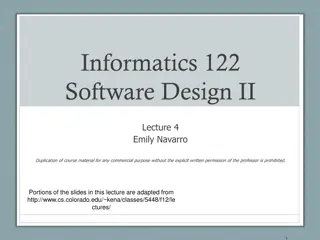Understanding C++11 Features and Design Patterns by Mark Redekopp
Explore the key concepts of C++11 features and design patterns explained by Mark Redekopp, focusing on static members, unique ID assignment for students, and the use of static data members in classes. Discover best practices for ensuring unique IDs for students and efficiently utilizing static members in C++ programming.
Download Presentation

Please find below an Image/Link to download the presentation.
The content on the website is provided AS IS for your information and personal use only. It may not be sold, licensed, or shared on other websites without obtaining consent from the author. Download presentation by click this link. If you encounter any issues during the download, it is possible that the publisher has removed the file from their server.
E N D
Presentation Transcript
1 CSCI 104 C++11 Features Design Patterns Mark Redekopp
2 STATIC MEMBERS
3 One For All As students are created we want them to have unique IDs How can we accomplish this? class USCStudent { public: USCStudent(string n) : name(n) { id = _________ ; // ???? } private: string name; int id; } int main() { // should each have unique IDs USCStudent s1("Tommy"); USCStudent s2("Jill"); }
4 One For All Can we just make a counter data member of the USCStudent class? What's wrong with this? class USCStudent { public: USCStudent(string n) : name(n) { id = id_cntr++; } private: int id_cntr; string name; int id; } int main() { USCStudent s1("Tommy"); // id = 1 USCStudent s2("Jill"); // id = 2 }
5 One For All It's not something that we can do from w/in an instance A student doesn't assign themselves an ID, they are told their ID Sometimes there are functions or data members that make sense to be part of a class but are shared amongst all instances The variable or function doesn't depend on the instance of the object, but just the object in general We can make these 'static' members which means one definition shared by all instances class USCStudent { public: USCStudent(string n) : name(n) { id = id_cntr++; } private: static int id_cntr; string name; int id; } // initialization of static member int USCStudent::id_cntr = 1; int main() { USCStudent s1("Tommy"); // id = 1 USCStudent s2("Jill"); // id = 2 }
6 Static Data Members A 'static' data member is a single variable that all instances of the class share Can think of it as belonging to the class and not each instance Declare with keyword 'static' Initialize outside the class in a .cpp (can't be in a header) Precede name with className:: class USCStudent { public: static int id_cntr; USCStudent(string n) : name(n) { id = id_cntr++; } private: string name; int id; } // initialization of static member int USCStudent::id_cntr = 1; int main() { USCStudent s1("Tommy"); // id = 1 USCStudent s2("Jill"); // id = 2 }
7 Another Example class USCitizen{ public: USCitizen(); All US Citizens share the same president, though it changes over time Rather than wasting memory for each citizen to store a pointer to the president, we can make it static However, private static members can't be accessed from outside functions For this we can use a static member functions private: static President* pres; string name; int ssn; } int main() { USCitizen c1; USCitizen c2; President* curr = new President; // won't compile..pres is private USCitizen::pres = curr; }
8 Static Member Functions Static member functions do tasks at a class level and can't access data members (since they don't belong to an instance) Call them by preceding with 'className::' Use them to do common tasks for the class that don't require access to an instance's data members Static functions could really just be globally scoped functions but if they are really serving a class' needs it makes sense to group them with the class class USCitizen{ public: USCitizen(); static void setPresident(President* p) { pres = p; } private: static President* pres; string name; int ssn; } int main() { USCitizen c1; USCitizen c2; President* curr = new President; USCitizen::setPresident(curr); ... President* next = new President; USCitizen::setPresident(next); }
9 It's an object, it's a function it's both rolled into one! DESIGN PATTERNS AND PRINCIPLES
10 Coupling Coupling refers to how much components depend on each other's implementation details (i.e. how much work it is to remove one component and drop in a new implementation of it) Placing a new battery in your car vs. a new engine Adding a USB device vs. a new processor to your laptop OO Design seeks to reduce coupling (i.e. loose coupling) as much as possible If you need to know or depend on the specific implementation of another class to write your current code, you are tightlycoupled BAD!!!! Code should be designed so modification of one component/class does not require modification and unit-testing of other components Just unit-test the new code and test the overall system
11 Design Principles Let the design dictate the details as much as possible rather than the details dictate the design Top-down design A car designer shouldn't say, "It would be a lot easier to make anti-lock brakes if the driver would just pulse the brake pedal 30 times a second" Open-Close Principle Classes should be open to extension but closed to modification (After initial design and testing that is) To alter behavior and functionality, inheritance should be used Base classes should be designed with that in mind (i.e. extensible) Extend and change behavior by allocating different (derived) objects at creation and passing them in (via the abstract base class pointer) to an object Did you use this idea during the semester? The client has programmed to an interface and thus doesn't need to change (is decoupled)
12 Re-Factoring f(x) = axy + bxy + cy How would you factor this? f(x) = y*(x*(a+b)+c) We pull or lift the common term out leaving just what is unique to each term During design implementation we often need to refactor our code which may include Extracting a common sequence of code into a function Extracting a base class when you see many classes with a common interface Replacing if..else statements based on the "type"
13 How to design effective class hierarchies with low coupling SPECIFIC DESIGN PATTERNS
14 Design Patterns Common software practices to create modular code Often using inheritance and polymorphism Researches studied software development processes and actual code to see if there were common patterns that were often used Most well-known study resulted in a book by four authors affectionately known as the "Gang of Four" (or GoF) Design Patterns: Elements of Reusable Object-Oriented Software by Erich Gamma, Richard Helm, Ralph Johnson and John Vlissides Creational Patterns Singleton, Factory Method, Abstract Factory, Builder, Prototype Structural Patterns Adapter, Fa ade, Decorator, Bridge, Composite, Flyweight, Proxy Behavioral Patterns Iterator, Mediator, Chain of Responsibility, Command, State, Memento, Observer, Template Method, Strategy, Visitor, Interpreter
15 Understanding UML Relationships UML Relationships http://wiki.msvincognito.nl/Study/Bachelor/Year_2/Object _Oriented_Modelling/Summary/Object- Oriented_Design_Process http://www.cs.sjsu.edu/~drobot/cs146/UMLDiagrams.htm Design Patterns Strategy Factory Method Template Method Observer
16 Iterator Decouples organization of data in a collection from the client who wants to iterate over the data Data could be in a BST, linked list, or array Client just needs to Allocate an iterator [it = collection.begin()] Dereferences the iterator to access data [*it] Increment/decrement the iterator [++it]
17 Strategy Abstracting interface to allow alternative approaches Fairly classic polymorphism idea In a video game the AI may take different strategies Decouples AI logic from how moves are chosen and provides for alternative approaches to determine what move to make Recall "Shapes" exercise in class Program that dealt with abstract shape class rather than concrete rectangles, circles, etc. The program could now deal with any new shape provided it fit the interface Client - Interface* if Interface Concrete ObjectA Concrete ObjectB MoveBehavior AI + makeMove() - MoveBehavior* if Aggressive Behavior Random Behavior
18 Your Search Engine Think about your class project and where you might be able to use the strategy pattern AND, OR, Normal Search string searchType; string searchWords; cin >> sType; SearchMode* s; if(sType == "AND"){ s = new ANDSearch; } else if(sType == "OR") { s = new ORSearch; } else { s = new SingleSearch; } client - SearchMode* if SearchMode + search() getline(cin, searchWords); s->search(searchWords); ANDSearch ORSearch SingleSearch Client
19 Factory Pattern A function, class, or static function of a class used to abstract creation Rather than making your client construct objects (via 'new', etc.), abstract that functionality so that it can be easily extended without affecting the client Item* i = factory.makeItem(type): Client << code >> Factory Item + makeItem() Concrete ItemA Concrete ItemB makeItem(int type) { if(type==A) return new ItemA; else if(type == B) return new ItemB; }
20 Factory Example We can pair up our search strategy objects with a factory to allow for easy creation of new approaches Factory Client class SearchFactory{ public: static SearchMode* create(string type) { if(type == "AND") return new ANDSearch; else if(searchType == "OR") return new ORSearch; else return new SingleSearch; } }; string searchType; string searchWords; cin >> sType; SearchMode* s = SearchFactory::create(sType); getline(cin, searchWords); s->search(searchWords); Search Interface class SearchMode { public: virtual search(set<string> searchWords) = 0; ... }; Concrete Search class AndSearchMode : public SearchMode { public: search(set<string> searchWords){ // perform AND search approach } ... };
21 Factory Example The benefit is now I can add new search modes without the client changing or even recompiling class SearchFactory{ public: static SearchMode* create(string type) { if(type == "AND") return new ANDSearch; else if(searchType == "OR") return new ORSearch; else if(searchType == "XOR") return new XORSearch; else return new SingleSearch; } }; string searchType; string searchWords; cin >> sType; SearchMode* s = SearchFactory::create(sType); getline(cin, searchWords); s->search(searchWords); class XORSearchMode : public SearchMode { public: search(set<string> searchWords); ... };
22 On Your Own Design Patterns Observer Proxy Template Method Adapter Questions to try to answer How does it make the design more modular (loosely coupled) When/why would you use the pattern Resources http://sourcemaking.com/ http://www.vincehuston.org/dp/ http://www.oodesign.com/
23 Templates vs. Inheritance Inheritance and dynamic-binding provide run-time polymorphism Example: Strategy *s; ; s->search(words); C++ templates provide compile-time inheritance class ANDSearch { public: set<WebPage*> search(vector<string>& words); }; class ORSearch { ... }; template <typename S> set<WebPage*> doSearch(S* search_mode, vector<string>& words) { return search_mode->search(words); } ... ANDSearch mode; Set<WebPage*> results = doSearch(mode, ...);
24 Templates vs. Inheritance Benefit of inheritance and dynamic-binding is its ability to store different-type but related objects in a single container Example: forEach shape s in Shapes { s->getArea(); } Benefit: Different objects in one collection Benefit of templates is less run-time overhead (faster) due to compiler ability to optimize since it knows the specific type of object used







